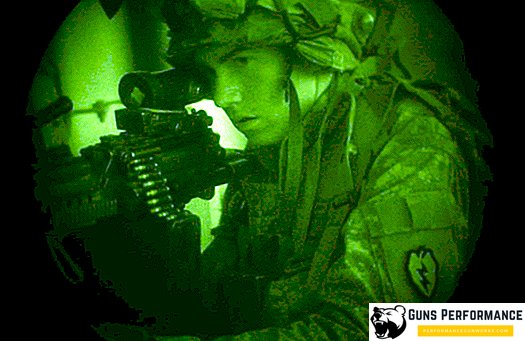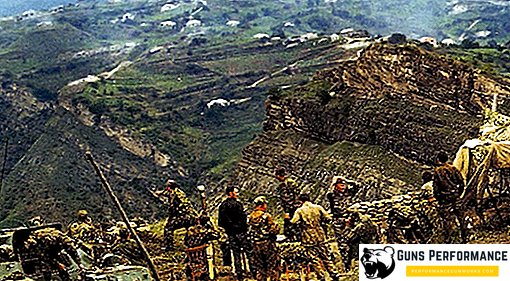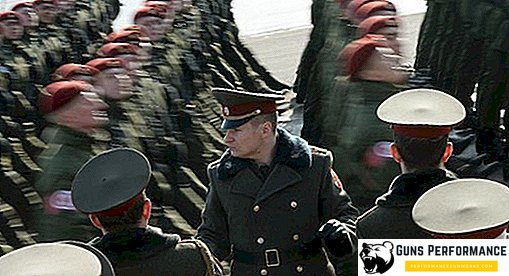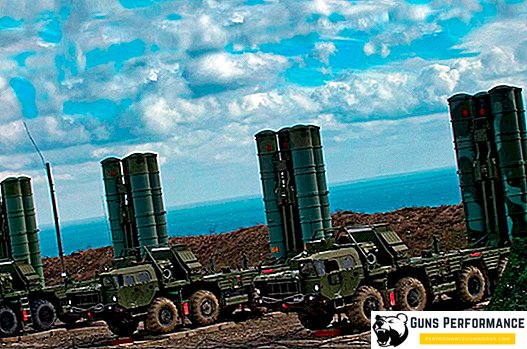
Vision is the most important way to perceive reality. Visually, we get most of the information about the outside world. Our eyes are a surprisingly complex and perfect mechanism, presented to us by nature. But, unfortunately, their possibilities are somewhat limited.
A person is able to perceive only a very narrow optical range of the entire spectrum of electromagnetic radiation (it is also called the visible part of the spectrum), moreover, the eye can perceive the “picture” only in conditions of sufficient illumination. For example, if it falls below the level of 0.01 lux, then we lose the ability to distinguish the colors of objects and we can see only large objects that are nearby.
This is doubly insulting, because because of this feature of our vision, we become almost blind in the dark. Man has always envied other representatives of the animal kingdom, for whom the night mist is not an obstacle: cats, owls, wolves, bats.
Especially did not like this limitation of human vision in the military. But the situation was drastically changed only in the middle of the last century, when, thanks to the achievements of physics, night vision devices appeared that made it possible to see at night almost as clearly as in the daytime.

Currently, night-vision devices are not only in army arsenals, they are used with pleasure by rescuers, hunters, security units, special services. And if we talk about thermal imagers, the list of their use is even wider.
Today, there is a huge amount of a wide variety of types and types of night-vision devices (NVD), made in the form of binoculars, mono-glasses (monoculars), sights or ordinary glasses. However, before we talk about the device of the night vision device, we should say a few words about the physical principles on which the work of such devices is based.
How does he work
The operation of night vision devices and thermal imagers is based on the physical phenomena of the internal and external photoelectric effect.
The essence of the external photoelectric effect (or photoelectron emission) is that solid bodies emit electrons under the influence of light, which are captured by the NVD. The basis of any night vision device is an image intensifier, an electron-optical converter that captures the weak reflected light, amplifies it and turns it into an electronic signal. This is what a person sees in the lens of a night vision device. It should be understood that no night vision device is able to “see” in absolute darkness. True, there are also active night vision devices, which use their own source of infrared radiation to illuminate objects.

Any night vision device consists of three main components: optical, electronic and another optical. Light is received by a lens, which then focuses it on an image intensifier, where photons turn into an electronic signal. The maximum amplified signal is transmitted to the luminescent screen, where it again becomes the image familiar to the human eye. The above design is generally characteristic of any generation of night vision devices, just modern night vision devices (second and third generation) have a more advanced signal amplification system.
Thermal imagers, on the other hand, capture their own radiation from any body or object whose temperature is different from absolute zero. The main part of the imagers are the so-called bolometers - complex photodetectors that capture infrared waves. Such sensors are sensitive to wavelengths corresponding to the temperature range from -50 to +500 degrees Celsius.

In fact, thermal imagers have a fairly simple design. Each such device consists of a lens, a thermal imaging matrix and a signal processing unit, as well as a screen on which the finished image is displayed. Thermal imagers are of two types: with a cooled and uncooled matrix. The first are the most sensitive, expensive and massive. Their matrix is cooled to a temperature of -210 to -170 o C, usually for this use liquid nitrogen. More often they are used on large military equipment (for example, any tank night-vision device).
Thermal imagers with an uncooled matrix cost much less, they are smaller in size, but their sensitivity is much lower. However, most of the thermal imagers that are on the market today (up to 97%) belong to this category.
One of the main features of thermal imagers, which largely determines their high cost, are their lenses. The fact is that ordinary glass used in most optical devices is completely opaque to infrared radiation. Therefore, such rare materials as germanium are used for lenses of thermal imagers, the market price of which is about 2 thousand dollars per kg. The average germanium lens for a thermal imager costs about 7 thousand dollars, and the price of a good one can reach up to 20 thousand dollars. Today, both in Russia and abroad, they are actively looking for a replacement for Germany, which in theory can reduce the cost of a thermal imager by 40-50%.
History and classification of NVD
The classification of night vision devices is based on the sensitivity of the photocathode, the degree of amplification of the light, and the resolution at the center of the resulting image. As a rule, there are three generations of NVD. In addition, early night vision devices with an additional source of infrared radiation are often referred to a separate generation. On the websites of manufacturers you can find information about the night vision devices of the so-called intermediate generations, like 1+ or 2+. However, such a gradation pursues more marketing objectives than it is a reflection of real differences.
Improving the design of NVD and the emergence of new generations of these devices went sequentially, one after another. Therefore, the classification of night vision devices is more convenient to consider together with the history of their development.
On August 23, 1914, near the Belgian city of Oostende, the Germans managed to find a British squadron consisting of armored cruisers and destroyers with the help of heat finders. And it is not easy to find out - but also to correct artillery fire with these devices, preventing the enemy ships from approaching an important port. It is believed that from that moment began the history of night vision devices.
In 1934 there was a real breakthrough in this area: the Dutchman Holst created the world's first electron-optical converter (EOC). Two years later, Russian expat Zvorykin developed an image intensifier with electrostatic signal focusing, which later became the “heart” of the first commercial night vision device of the American company Radio Corporation of America.

The period of rapid development of NVD was the Second World War. The leader in their development and application was Hitler's Germany. The first prototype of the night-vision sight was created by the German company Allgemeine Electricitats-Gesellschaft (AEG) in 1936, it was intended for installation on the Pak 35/36 L / 45 anti-tank guns.
By 1944, the German Pak 40 anti-tank guns could fire using night-vision devices at a distance of up to 700 meters. At about the same time, the Wehrmacht’s tank forces received the Sperber FG 1250 night vision device, using which the last major German offensive took place on the Eastern Front near the Hungarian Lake Balaton.

All of the above night-vision devices belong to the so-called zero generation. Such devices were very sensitive, so for their normal operation an additional source of infrared light was needed. For example, every five German tanks equipped with a Sperber FG 1250, accompanied by an armored personnel carrier with a powerful infrared locator Uhu ("Filin"). In addition, zero-generation PNVs had an image intensifier sensitive to bright flashes of light. That is why at the end of the war, Soviet troops often used conventional searchlights in the offensive. They simply blinded German PNV.
The Germans had attempts to create and night vision devices that would provide a greater vision range (up to 4 km), but due to the considerable size of the IR illuminator, they were abandoned. In 1944, an experimental batch (300 pcs.) Of the Vampir PNV was sent to the troops, intended for installation on the German Sturmgever assault rifles. In addition to the sight itself, it consisted of an infrared illuminator and a rechargeable battery. The total weight of the device exceeded 30 kg, the range - 100 meters, and the time of its operation was only 20 minutes. Despite these rather modest figures, the Germans actively used “Vampire” in the night battles of the final stage of the war.
Attempts to create zero-generation NVD were in the Soviet Union. Even before the war, the Dudka complex was developed for the BT family of tanks, later a similar system appeared for the T-34. You can also recall the domestic night-vision device Ts-3, which was developed for PPSh-41 submachine guns. Similar weapons were planned to equip assault units. However, the NVD did not receive widespread use in the Red Army. At that time, night-vision devices were still exotic, and the Soviet Union during World War II was definitely not up to it.

The experience of the Second World War showed that night-vision devices have excellent prospects. It became clear that this technology can seriously change the way of conducting combat operations not only on land, but also in the air and at sea. However, for this, the zero-generation NVD had to get rid of a large number of inherent flaws, the main of which was their low sensitivity. It not only limited the range of the NVD, but also forced to use a bulky and very energy-intensive IR illuminator with the device. On the whole, the design of the first night vision devices was too complicated and did not differ in sufficient reliability.
Soon, the first generation devices based on electro-opto-electrochemical tubes with electrostatic focusing replaced the primitive night vision devices of the military period. They were able to amplify the input signal several thousand times. This, in turn, made it possible to refuse additional lighting. IR illuminators not only unnecessarily made the system heavier, but also unmasked the fighter on the battlefield. The peak of their perfection of the first generation of NVGs reached by the 60s of the last century, the Americans actively used them during the Vietnam War.

Second-generation night-vision devices appeared due to the emergence of a revolutionary microchannel technology, this happened in the 70s. The essence of it was that now the optical plates were studded with hollow channel tubes with a diameter of 10 μm and a length of no more than 1 mm. Their number determined the resolution of the light guide plate. A photon of light, falling into each of these channels, causes a whole cascade of electrons to be knocked out, which greatly increased the sensitivity of the device. For the second generation of NVG, the gain can reach 40 thousand times. Their sensitivity is 240-400 mA / lm, and the resolution - 32-56 lines / mm.
In the Soviet Union, night-vision goggles "Quaker" were created on the basis of this technology, and in the USA - AN / PVS-5B.
Later, night-vision devices appeared in which the electrostatic lens is absent altogether and the direct transfer of electrons to the microchannel plate takes place. Such night vision devices are usually referred to as generation 2+. On the basis of such a scheme, domestic eyeglasses "Eyecup" or their American analogue AN / PVS-7 were made.

Further efforts of scientists to improve night vision devices were aimed at improving the photocathode. Philips engineers have offered to make it out of a new semiconductor material - gallium arsenide.
That is how the third generation night vision devices appeared. Compared to traditional multi-alkaline photocathodes, their sensitivity became higher by 30%, which made it possible to carry out observations even in a cloudless moonless night. The only problem was that the new material could be made only in conditions of high vacuum, and this process turned out to be very laborious. Therefore, the cost of such a photocathode turned out to be an order of magnitude higher than that of its predecessors. at the same time, the third generation of NVGs can amplify the incoming light by 100 thousand times. You can also add that only two countries can produce gallium arsenide on an industrial scale - the United States and Russia.

If you see information about the sale of fourth-generation NVG somewhere, then keep in mind: most likely, you are being deceived. It does not exist yet, it is not even clear what criteria to use to determine this group. Although, of course, research to improve the existing "night lights" are conducted in dozens of countries around the world. For thermal imagers, they are looking for a budget replacement of glass from Germany, the main problem of night vision devices is the search for a cheaper analogue of gallium arsenide photocathodes. At the beginning of the 2000s, the Americans announced the creation of a new generation of NVGs, but some experts believe that it can rather be called the 3+ generation.
Applications and Prospects
Devices that allow a person to see at night, every year are becoming more popular and find new areas of application. Modern "civilian" night vision devices have an affordable price, so hunters, security structures, and other categories of citizens who need night vision can afford them.
The most interesting thing is that today all three generations of night vision devices are present on the market. Many night-vision devices for hunting belong to the first generation or even zero and have IR illumination, which is absolutely unacceptable for military NVGs. On the "citizen" are also used and third-generation devices (they can be seen even in the basement). The technologies that are used to create them have not been secret for a long time, just devices are very expensive. Scope NVD can also be made using elements of different generations.

The use of thermal imagers has also long ceased to be the exclusive prerogative of the military. In addition to hunting and observation in the dark, similar devices are increasingly used in scientific research. With their help, for example, they check the spacecraft before launch: the imager perfectly shows various leaks that can lead to a catastrophe. Indispensable thermal imager and energy. This device can easily show where heat is most actively escaping from a building, and will also allow it to detect places of maximum loads in power grids. Thermal imagers and medicine are used: according to the temperature map of the human body, you can even make some diagnoses. Every year, these devices are becoming cheaper, so their scope of application is steadily expanding.












